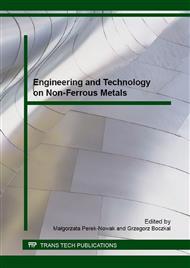[1]
T. Wrobel, J. Szajnar, Modification of pure al and AlSi2 alloy primary structure with use of electromagnetic stirring method, Archives of Metallurgy and Materials 58 (2013) 941-944.
DOI: 10.2478/amm-2013-0106
Google Scholar
[2]
M. St. Węglowski, S. Dymek, Relationship between Friction Stir Processing parameters and torque, temperature and the penetration depth of the tool, Archives of Civil and Mechanical Engineering 13 (2013) 186-191.
DOI: 10.1016/j.acme.2013.01.003
Google Scholar
[3]
M.L. Santella, T. Engstrom, D. Storjohann, T. -Y. Pan, Effects of friction stir processing on mechanical properties of the cast aluminum alloys A319 and A356, Scripta Materialia 53 (2005) 201-206.
DOI: 10.1016/j.scriptamat.2005.03.040
Google Scholar
[4]
B. Rams, A. Pietras, K. Mroczka, Friction stir welding of elements made of cast aluminium alloy, Archives of Metallurgy and Materials 59 (2014) 385-392.
DOI: 10.2478/amm-2014-0064
Google Scholar
[5]
A. Węglowska, Effect of vibration welding parameters on the quality of joints made of polyamide 66, Polimery 59 (2014) 239-245.
DOI: 10.14314/polimery.2014.239
Google Scholar
[6]
A. Węglowska, A. Pietras, Influence of the welding parameters on the structure and mechanical properties of vibration welded joints of dissimilar grades of nylons, Archives of Civil and Mechanical Engineering 12 (2012) 198-204.
DOI: 10.1016/j.acme.2012.03.009
Google Scholar
[7]
A. Węglowska, Research into linear vibration welding of glass fibres reinforced nylon 66, Welding in the World 59 (2015) 339-352.
DOI: 10.1007/s40194-014-0203-2
Google Scholar
[8]
M. St. Weglowski, K. Kwiecinski, K. Krasnowski, R. Jachym, Characteristics of Nd: YAG laser welded joints of dual phase steel, Archives of Civil and Mechanical Engineering 9 (2009) 85-97.
DOI: 10.1016/s1644-9665(12)60072-7
Google Scholar
[9]
M. St. Weglowski, S. Stano, K. Krasnowski, M. Lomozik, K. Kwiecinski, R. Jachym, Characteristics of Laser Welded Joints of HDT580X Steel, Materials Science Forum 638-642 (2010) 3739-3744.
DOI: 10.4028/www.scientific.net/msf.638-642.3739
Google Scholar
[10]
A. Steuwer, M.J. Peel, P.J., Withers, Dissimilar friction stir welds in AA5083–AA6082: The effect of process parameters on residual stress, Mat Sci Eng A 441 (2006) 187–196.
DOI: 10.1016/j.msea.2006.08.012
Google Scholar
[11]
M. Peel, A. Steuwer, M. Preuss and P. J. Withers, Microstructure, mechanical properties and residual stresses as a function of welding speed in aluminium AA5083 friction stir welds, Acta Mater, 51 (2003) 4791-4801.
DOI: 10.1016/s1359-6454(03)00319-7
Google Scholar
[12]
M. St., Węglowski, P. Sedek, C. Hamilton, Experimental and numerical analysis of residual stress in cast aluminum alloy after FSP process, Key Engineering Materials 651-653 (2015) 1563-1568.
DOI: 10.4028/www.scientific.net/kem.651-653.1563
Google Scholar
[13]
S. Sadeghi, M.A. Najafabadi, Y. Javadi, M. Mohammadisefat, Using ultrasonic waves and finite element method to evaluate through-thickness residual stresses distribution in the friction stir welding of aluminum plates, Materials and Design 52 (2013).
DOI: 10.1016/j.matdes.2013.06.032
Google Scholar
[14]
D.R. Ni, D.L. Chen B.L. Xiao, D. Wang, Z.Y. Ma, Residual stresses and high cycle fatigue properties of friction stir welded SiCp/AA2009 composites, International Journal of Fatigue 55 (2013) 64–73.
DOI: 10.1016/j.ijfatigue.2013.05.010
Google Scholar
[15]
C. Hamilton, M. Kopyściański, O. Senkov, S. Dymek, A Coupled Thermal/Material Flow Model of Friction Stir Welding Applied to Sc-Modified Aluminum Alloys, Metallurgical and Materials Transactions A, 44 (2013) 1730-1740.
DOI: 10.1007/s11661-012-1512-y
Google Scholar
[16]
C. Hamilton, M. St. Węglowski, S. Dymek, A simulation of friction stir processing for temperature and material flow, Metall Mater Trans B, 46 (2015) 1409-1418.
DOI: 10.1007/s11663-015-0340-z
Google Scholar
[17]
C. Hamilton, M. St. Węglowski, S. Dymek, P. Sedek, Using a Coupled Thermal/Material Flow Model to Predict Residual Stress in Friction Stir Processed AlMg9Si, Journal of Materials Engineering and Performance 24 (2015) 1305-1312.
DOI: 10.1007/s11665-015-1402-8
Google Scholar
[18]
Z.Y. Ma, S.R. Sharma, R.S. Mishra, Microstructural Modification of As-Cast Al-Si-Mg Alloy by Friction Stir Processing, Metallurgical and Materials Transactions A 37A (2006) 3323-3336.
DOI: 10.1007/bf02586167
Google Scholar


